Seasonic Power Supplies are much sought after for their reliability and rock solid voltage. We’re lucky enough to have the Seasonic M12D 850 Watt Modular in house for testing.
INTRODUCTION
Hardly a day goes by that someone doesn’t ask us if this PSU or that PSU will drive a system. Often the choices made are more based on price and bling than the actual quality of the PSU. Price and Bling are two of the last things you should look at when it comes to PSU. Having been in the computer business for as long as computers have been around I’ve seen almost every PSU horror story play out that you can imagine.
I’ve seen systems that are worth hundreds and thousands of dollars fall to poor PSU choices. I’ve seen one PSU kill two motherboards in a row because they thought buying a flea market PSU was a good idea. I’ve seen video cards that cost $300 (USD) and more die because people thought their PSU would be enough to drive the GPU. You name it I’ve seen it. Including a $20 dollar 650 Watt PSU burn down part of a house. Computer PSU’s aren’t something to skimp on.
Generally the two schools of thought run something like this. “I’ve never had a problem with my (insert name here) PSU and I’ve been using it for 3 years, I bought it because it was cheap.” Then there’s the; “I only use the best PSU’s because my system is expensive and important to me.” The first school of thought there’s 2 things wrong with that, it’s 3 years old and PSU loose efficiency with time, so your paying for a new PSU on the electric bill. Second it’s a cheap PSU. Very seldom do you see good and cheap in the same sentence when it concerns PSU. That’s because they are almost always mutually exclusive. The second school of thought, those in the know, we applaud you.
You can take your chances in the PSU crap shoot and go cheap, or you can buy a quality PSU like the Seasonic M12D 850 Watt Modular and know that you will enjoy a long safe computing experience. Keep in mind that cheap PSU might still be running but, PSU that are cheap don’t provide good solid voltage so every time you push that button your shortening the life of your computer. Be smart, go with a good quality PSU from a manufacturer like Seasonic that will provide years of good service and keep that gaming shrine safe from the dreaded flea market PSU catastrophe.
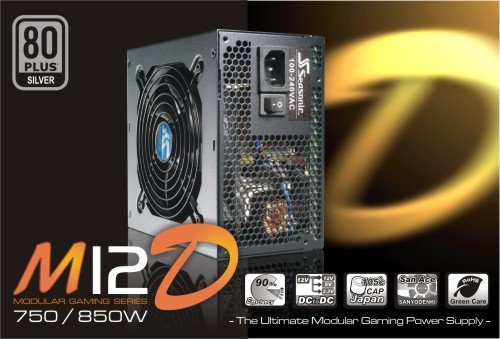
About Seasonic
Since the incorporation of Sea Sonic Electronics Co., Ltd. in 1975, we have maintained our focus on research and development and the production of quality power conversion products.
For the past decades, supported by cutting edge technology based upon a strong research and development team, Sea Sonic Electronics has provided timely and professional solutions to meet many of the IT industry’s requirements.
For the future, we will continue our philosophy of dedication; innovation, professionalism and 4G’s (Great Technology, Great Quality, Great Service & Great Price) in order to maintain our goal of continued long-term business partnerships and create “win-win” situations for our customers.
FEATURES & SPECIFICATIONS
- – Super High Efficiency
- – DC to DC Converter Design
- – Practical Dual +12V Rails
- – Tight Voltage Regulation
- – High Reliable 105°C Japanese Capacitors
- – Solid Caps on 12Vs for Extreme Stress Operation Conditions
- – Active Power Factor Correction [99%PF]
- – Dual Sided PCB Layout
- – Detachable Modular Cable
- – San Ace Silent Fan
- – Smart & Silent Fan Control [ S²FC]
- – Ultra Ventilation
- – All in One DC Cabling Design
- – Universal AC Input
- – Patented Easy Swap Connector
- – 5 Year Warranty
Right off the bat you can tell that Seasonic chose to use high quality 105°C Japanese capacitors. They provide better power regulation, longer life, higher efficiency. They also went with a more stable dual 12v Rail design than a lot of Quad rail PSU’s use, and while we’d rather see a single large rail, but we don’t have a problem with a high quality dual rail design. The 12v rails utilize solid caps for the added stress of today’s power hungry systems and help to prevent catastrophic failure, and promote longer life. Active PFC provides better efficiency and is a feature you should look for on your next PSU purchase.
They also use a superior design dual sided PCB arrangement, and we’d call it a partially modular design. While some might frown on partially modular we see it as an advantage in some cases. Some of the connectors might be harder to route through the system but each modular connection adds some resistance to the circuit so having the wires you know your going to use hard wired can be a good thing.
They use the honeycomb designed rear vents that are becoming standard for PSU cooling and provide better ventilation than previous round, and square vents. They also toss in a high quality variable speed Sanyo Denki fan that will ramp up as load increases to keep your PSU nice and cool.
They are also providing an industry leading 5 year warranty. It’s hard to go wrong with a PSU that incorporates high quality components, backed by a worldwide vendor that takes enough pride in their product to cover failure for 5 years.
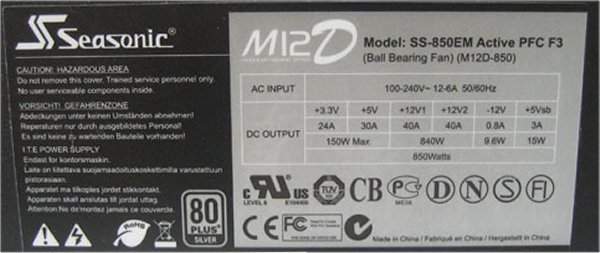
We got a decent picture of the Rails Voltage panel on this one, but we thought we’d throw in the graphic from the Seasonic website for those that would like to see it in a more palatable manner.

The Seasonic M12D 850 watt PSU has a total of 80 Amps on the two 12v rails and that should be plenty to drive most enthusiast class systems with up to two top GPU’s in SLI or Crossfire. If your one of the 3% running triple or quad GPU’s then you might need a larger PSU but we’d venture a guess that this would cover the bulk of systems out there.
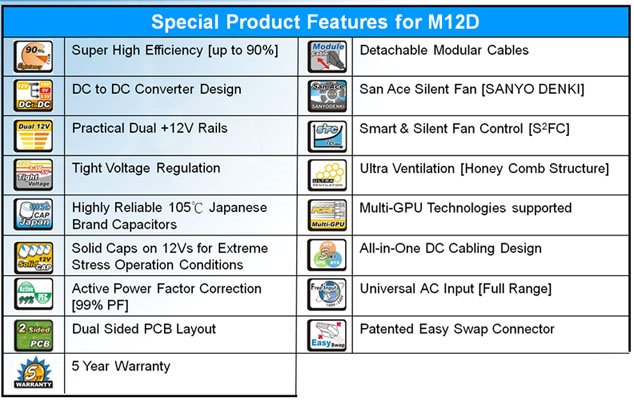
This graphic we found in the press pack illustrated a lot of the Seasonic M12D’s special features better than a full page of words. One thing we found interesting was the DC to DC converter.

The innovation of DC to DC converters in the PSU industry is quite new. So new that Seasonic sent one separate from the PSU itself so we could get a good beauty shot of it. What it does for you is it splits the 3.3v and 5v rails away from the 12v rails and provides loadup protection. By that we mean less cross loading, it prevents mis-balanced cross regulation during the initial load of the system, and maximizes utilization on the 12v rails.

Efficiency has long been a concern with computer PSU’s as energy costs increase. New standards of efficiency have emerged, the Seasonic M12D fits in the center of the top three categories and rates a 80Plus Silver rating. What that translates to the end user as is a savings of up to $44 dollars a year over a decently modern generic 80Plus PSU. If your hanging onto that 3 year old PSU we mentioned earlier, then you can save as much as $187 a year. See what we meant about paying for a new PSU but driving an old one.
Before we move on to the “What About Them Rails Section” lets take a look at the emerging rating system.

If a PSU is rated 80 Plus that’s what you can expect, an 80% conversion from AC to DC. so for every 100 Watts going into the PSU from the wall, 80 Watts are provided to the computer for use. The other 20% is dissipated as heat. With 80 Plus Bronze you get 82-85% conversion, and 80 Plus Silver you get 85-88% conversion, and 80 Plus Gold 87-90% of the total going in is provided to the computer. The Seasonic M12D is 80 Plus Silver which is really good, but you get 2% better power conversion with the Gold model. If you insist on a Gold model you better believe your going to pay for that Gold.
WHAT ABOUT THEM RAILS?
We have all, no doubt, been told that when purchasing a power supply that the number to look for is the amps on the 12V rail. What are each of the different rails for though, and why is the 12V rail typically the most important? Why the heck are they called rails? Let’s take at look at each and see.
-12V – This rail is pretty much obsolete now and is only kept on to provide backward compatibility with older hardware. Some older types of serial port circuits required both -12V and +12V voltages, but since almost no one except industrial users use serial ports anymore you as a typical home user can pretty much disregard this rail.
-5V – Again this is another obsolete rail, the -5V was used for old school floppy controllers and some ISA bus cards. Again, no need for the typical home user to worry about this rail.
0V – Though not listed on any manufacturer spec sheet, every power supply has a 0V ground line. The ground signal is used to complete circuits with other voltages and provide a plane of reference against which other voltages are measured.
+3.3V – Finally we are starting to get into something useful! The +3.3V rail was introduced with the ATX form factor in order to power second generation Pentium chips. Previously the CPU was powered by the +5V rail (along with the system memory and everything else on the motherboard), but a reduced voltage was needed in order to reduce power consumption as the chips got faster. Until just recently, the +3.3V was used to exclusively power the CPU as well as some types of system memory, AGP video cards and other circuits.
+ 5V – As mentioned above, the +5V used to run the motherboard, CPU and the majority of other system components on older pre ATX based systems. On newer systems, many of the components have migrated to either the +3.3V or +12V rails, but the motherboard and many of its onboard components still use the +5V rail so it is of importance to the typical home user.
+5V SB – The +5V Standby or “Soft Power” signal carries the same output level as the +5V rail but is independent and is always on, even when the computer is turned off. This rail allows for two things. First, it allows the motherboard to control the power supply when it is off by enabling features such as wakeup from sleep mode, or wake on LAN technology to function. It also is what allows Windows to turn your computer off automatically on shutdown as opposed to previous AT supplies where you had to bend over and push the button. Every standard ATX power supply on the market will include this rail.
+ 12V – The +12V, also known as the mother of all rails, is now used to power the most demanding components in your system including the CPU, hard drives, cooling fans, and graphics cards. Historically the +12V rail was used only to power drives and cooling fans. With the introduction of the 4-pin CPU plug on P4 motherboards and then eventually AMD based motherboards, in order to supply newer power hungry CPUs, the +12V rail suddenly started to grow in importance. Today, dual core based motherboard require an 8-pin +12V connector to supply their power needs. High end GPU cards have also jumped on the +12V rail, which has required PSU makers to adapt. Where previously there was only a single +12V rail, there are now two or more, each designated to power specific devices in order to ensure that nothing is underpowered.
Now as to why they are called rails, the best explanation that I can find is that the term comes from the wacky world of electronics and it refers to a long metal bar or strip that is used to provide a particular voltage level. Perhaps someone with a deeper understanding of all things electrical could let me know whether or not that is true.
ATX 12V V2.2 Standard
ATX 2.20
2.20 is where we currently stand as of March 2005. It was released the same month as the short lived 2.1 revision which is why you won’t see any units bearing that standard. The 2.20 again increased the efficiency requirements which now stand at a minimum of 65% or greater and a recommended level of 75% or greater. The +5VSB rail has also been increased to 2.5A
In short any power supply post 2.0 will do the job for you. The biggest advantage of purchasing a latter standard model would seem to be the increase in efficiency rating.
EPS12v Standard
The EPS12V specification is one of those standards that most people have heard about, but very few know what it actually does. The EPS spec itself is defined in the Intel Server System Infrastructure (SSI) spec and is currently at v2.1.
The EPS12V spec dictates that Power Supply units must have a 24pin 12V connector as well as one additional 8-pin 12V connector. If a PSU is noted as EPS12V compliant you can be assured that it will have all the connections you need to power your new dual core based system, however it should also be noted that units do not necessarily have to meet EPS12V spec to include an 8-pin 12V connector.
My “What About Them Rails?” section needs a little updating but it’ll provide enough current information that it’s still useful for the novice hunting for a viable PSU for that gaming monster their building.
PICTURES & IMPRESSIONS

The Seasonic M12D comes in an attractive box with plenty of information and specifications on it to help inform the consumer about it’s purchase.
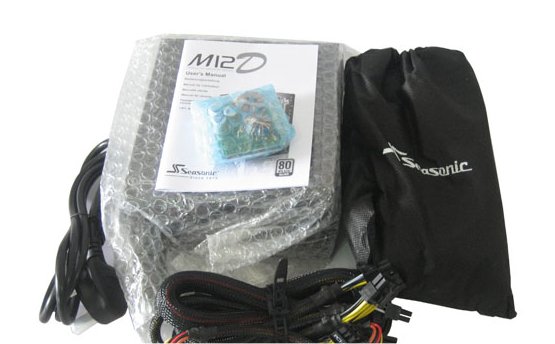
The packaging was substantial enough to protect the PSU in it’s arduous journey. Please note that the DC to DC converter on top the manual won’t be in the retail version you receive, it was included for pictorial purposes.

The modular cables come in a nice bag to help you keep track of them. We’re really glad that they put the names on the bags because with a closet full of PSU the cables all start to look alike.
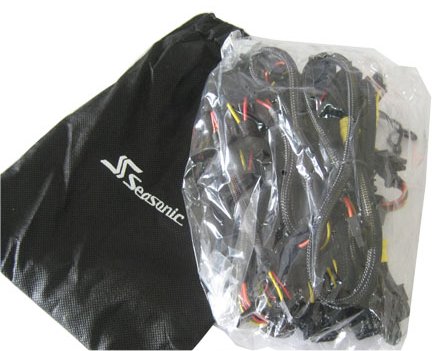
Inside the handy bag we fing what, another bag of cables. A little redundant but we can’t complain about a little more protection.
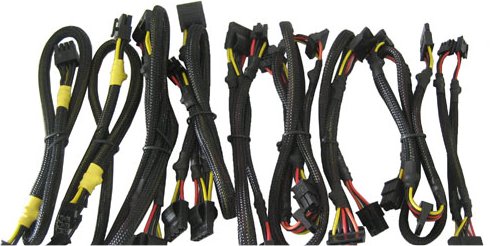
Then when you get every thing torn apart there’s plenty of cables for most enthusiast systems.
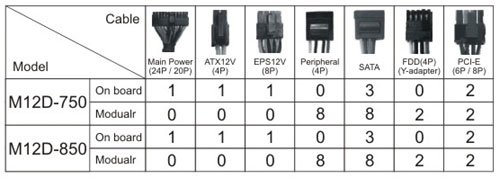
Rather than create some convoluted table with all the cables listed we went ahead and snatched the cable diagran out of the press packet we received. You get one main power connector, 1 ATX 12v 4 pin, 1 EPS 12v 8 pin, 3 wired Sata, 8 modular Sata, 2 floppy connectors, and two 6pin PCI-E and 2 PCI-E 8 Pin.

There’s a look at the high quality Sanyo Denki San Ace 120mm fan inside the casing through the fan grill. Sanyo Denki San Ace fans are known for their longevity, and superior cooling. They are also know to produce the same amout of airflow as much louder fans but do it whisper quiet and we are starting to see them in a lot more PSU’s.
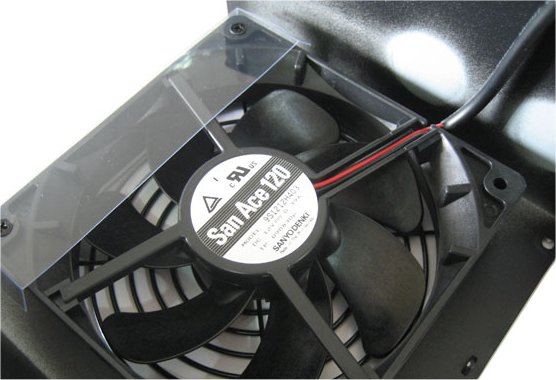
Yes we yanked this powerhouse apart to see waht was going on, and true enough it’s a San Ace fan. Notice the fan shield, that will interfere with airflow a little but nothing to worry about. Better a little less airflow than a wire shifting and stopping the fan all together.
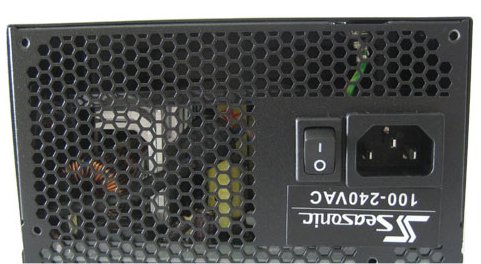
There’s a look at the ever more popular honeycomb design we’re seeing on a lot of the most modern PSU’s these days. The honeycomb design provides better airflow than previous designs because it offers less obstruction to the normal flow of air than say round holes.
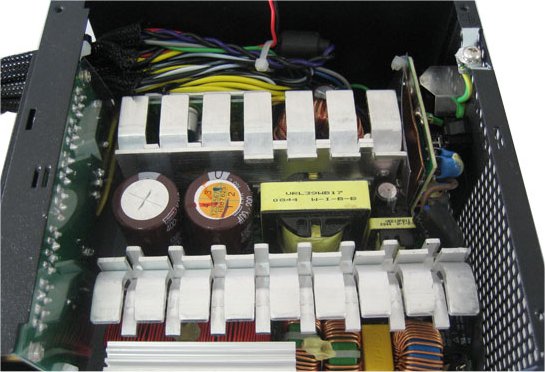
Now that’s what we like to see inside a Power Supply, nice tight wiring, high quality Japanese capacitors, large heat sinks, and well done solder points.
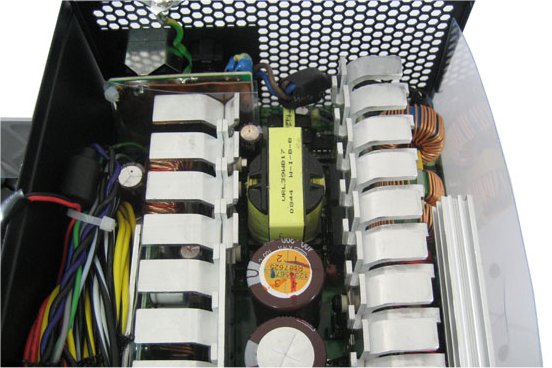
A well engineered PSU ripped apart is a thing of beauty. You can tell a lot just by the careful placement of the components and solder points.

The connector panel is simple, easy to get at and well constructed. It’s plainly marked to help you figure out which wire goes where. If you will please notice all the wires are well sleeved to protect them and where the main wire bundle comes out of the PSU it’s well protected with a grommet.

The install was a breeze but like most new PSU the cables were a little stiff. We didn’t put it to the acid test but we’d offer the advice of being careful installing because scratches are going to stand out on that finish.
TESTING & METHODOLOGY
When it comes to power supplies, any power supply, what you’re really looking for is good clean voltage and plenty of it. Current standards are 5% variance on any rail maximum, which is a little more lax than my personal standard of 3% max everywhere but the +5vSB (+5v stand by) which is always on even when the power supply and computer are off. On the +5vSB it’s not unusual to see 5% and since it’s only for wake on Lan or by device feature it’s not a big deal.
Thermaltake out tells you that they hold to a higher standard than 5%, they hold to a 3% standard which is what we like to see in any power supply.
Like a lot of you enthusiasts out there, our PC’s are an ongoing work of art that we have a lot of cash invested in. If a PSU won’t hold to 2 or 3% load/idle no matter what we do to it, we won’t use it or recommend it.
Testing Equipment
| Thermaltake Toughpower 1K Testing Equipment |
|
| Multimeter | Craftsman |
| LCD Voltage Tester | Coolmax Digital LCD PSU Tester |
| Thermometer | Micro Temp Digital Infrared Thermometer |
| Connectors | 24 Pin Motherboard Connector Splitter |
| Wall Voltage | Kill A Watt Voltage Measurement Device |
We do things a little different than a lot of testers with Power Supplies. We take readings with a Craftsman multimeter, then we use a 24 pin Motherboard Connector splitter to connect to the PSU and the Mobo leaving one connector open for a Digital LCD PSU tester to connect to during load and idle tests. This gives the advantage of measuring all the same voltages you can test with a multimeter plus we get the -12v which can’t be tested with a multimeter, and the +5vSB. Then I also use an IR thermometer to record the input air temperature and exhaust temperature because the input/output temps can tell you how hard the PSU is working to provide the voltage.
Test Rig
| Test Rig “Quadzilla” |
|
| Case Type | Top Deck Testing Station |
| CPU | Intel Core I7 965 Extreme (3.74 GHz 1.2975 Vcore) |
| Motherboard | Asus P6T Deluxe (SLI and CrossFire on Demand) |
| Ram | G.Skill DDR 3 1600 (9-9-9-24 1.5v) 6GB Kit |
| CPU Cooler | Thermalright Ultra 120 RT (Dual 120mm Fans) |
| Hard Drives | Intel 80 GB SSD X25-M G.Skill 64GB SSD FM-25S25-64GB WD Raptor 150GB WD1500ADFD |
| Optical | Sony DVD R/W |
| GPU | Two EVGA GTX-280’s in SLI Drivers 180.43 |
| Case Fans | 120mm Fan cooling the mosfet cpu area |
| Docking Stations | Tagan IB290 W/Deskstar 2 1/2 Inch 80 Gig Sata 2 Tagan IB390 W/Maxtor 160 Gig Sata 2 Thermaltake BlackX USB W/Seagate 80 Gig Sata 2 |
| Testing PSU | Thermaltake Toughpower 1200 Watt Modular Seasonic M12D 850 Watt |
| Legacy | None |
| Mouse | Razer Lachesis |
| Keyboard | Razer Lycosa |
| Gaming Ear Buds |
Razer Moray |
| Speakers | None |
| Any Attempt Copy This System Configuration May Lead to Bankrupcy | |
TESTING RESULTS
The current ATX 2.2 specifications allow for the following variation in voltage outputs:
- 3.3 Volt Rail: 3.135V – 3.465V
- 5 Volt Rail: 4.75V – 5,25V
- 12 Volt Rail: 11.4V – 12.6V
|
Power Output Results(V) |
||||||
| Power Rail | Thermaltake Toughpower 1200 Watt |
Seasonic M12D 850 Watt |
||||
| Idle | Load | Idle | Load | |||
| 3.3v | 3.31 | 3.32 | 3.31 | 3.32 | ||
| 5v | 5.03 | 5.05 | 5.03 | 5.02 | ||
| 12v1 | 12.07 | 12.06 | 12.05 | 12.05 | ||
| 12v2 | 12.09 | 12.10 | 12.04 | 12.05 | ||
| 12v3 | 12.11 | 12.12 | N/A | N/A | ||
| 12v4 | 12.11 | 12.05 | N/A | N/A | ||
| 5vSB | 5.01 | 5.03 | 5.04 | 5.03 | ||
| Wattage Used | Idle Power: 263Watt(± 5%) Load Power: 544Watt(± 5%) |
|||||
Testing with as much load as we could throw at the Seasonic M12D 850 Watt did as well as any PSU we’ve seen and better than almost all of them. We ran GTX-280 SLI with the Seasonic and it didn’t even heat up indicating that it held the load we put on it without signifigant strain. Results show that it was running in the 1% variance range on any rail which is 5 times beter than current standards, and 3 times better than our current standard.
Power Factor Test Results
|
Power Factor Percentage |
||
| Power Supply | Idle | Load |
| Thermaltake Toughpower 1200 Watt | 96% | 97% |
| Seasonic M12D 850 Watt | 96% | 97% |
Power factors reading on the Seasonic show that it has the same level of efficiency as the Thermaltake we tested it against. Both Seasonic and Thermaltake Toughpower are hard to beat.
Air Input/Output Temperature Results
|
Air Input/Output Temperature Results |
||
| Power Supply | Input Temp. | Output Temp. |
| Thermaltake Toughpower 1000 Watt | 24C | 36C |
| Seasonic M12D Watt | 23C | 35C |
| Ambient | 22C | 22C |
|
Ambient Measured Inside The Room By The Case |
||
Even with Dual SLI running on the test rig temperatures remained reasonable with the exhaust temperatures on both the tested power supplies. The Thermaltake seemed to be working a little harder and it got 1C hotter than the Seasonic.
CONCLUSION
The Seasonic M12D turned out to be one of the few PSU we’ve ever tested that lives up to the marketing hype that accompanies most PSU. It not only lives up to the marketing information, it exceeds the promises they make. With around 1% variance on any rail it is one of the most stable PSU we’ve ever tested. Even trying to trick the circuits inside the PSU by quickly shifting from load to idle we didn’t see any fluctuation on the Multimeter or PSU tester we used for testing. It was so much fun trying to trick it that we spent better than an hour going from Idle to Load and the PSU barely noticed. Voltage fluctuation might have flickered down in the .05v range going Load to Idle. That’s seriously impressive for a PSU to not even notice that you just cranked up 2 GTX-280’s then as soon as they hit load shut them down.
The Seasonic M12D met and exceeded our expectations. We wouldn’t have any problem recommending it for any Single or Dual GPU system we’ve seen to date.
We are trying out a new addition to our scoring system to provide additional feedback beyond a flat score. Please note that the final score isn’t an aggregate average of the new rating system.
- Performance 10
- Value 8
- Quality 10
- Warranty 10
- Features 10
- Innovation 10
Pros:
+ Nice Clean Power & Plenty Of It
+ SLI & Crossfire Ready (2 GPU’s)
+ Quiet
+ Even Under Heavy Load Temperatures Stay Pretty Cool
+ Plenty of Connectors
+ Modular
+ The Most Stable Voltage We’ve Ever Seen
Cons:
– Price Might Set Some People Back
– Not Getting One Sooner
The rock solid voltage regulation on the Seasonic M12D, combined with the industry leading 5 year warranty, friendly service and support and well know quality of Seasonic earn it a:
Final Score: 9.5 out of 10 and the Bjorn3D Golden Bear Award.
 Bjorn3D.com Bjorn3d.com – Satisfying Your Daily Tech Cravings Since 1996
Bjorn3D.com Bjorn3d.com – Satisfying Your Daily Tech Cravings Since 1996




